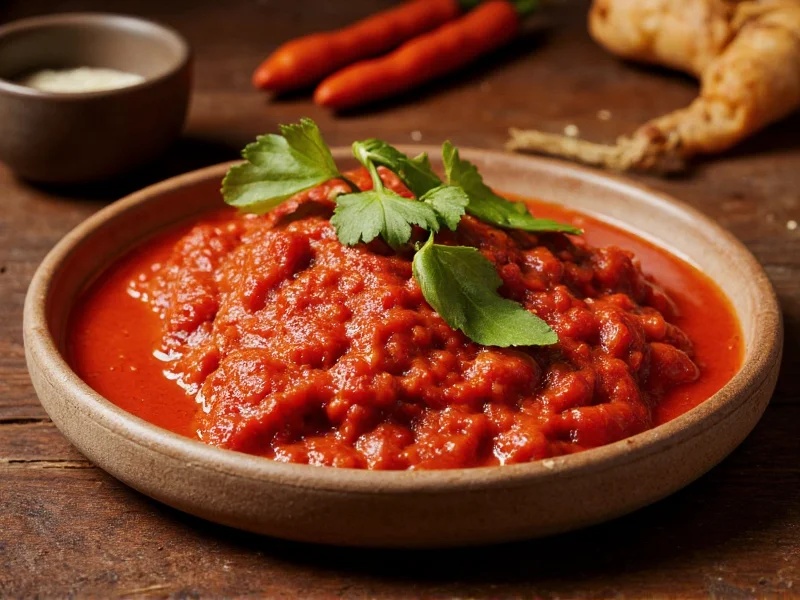Harissa has become a global pantry staple, but many newcomers wonder how hot is harissa sauce before adding it to their dishes. Understanding its heat profile helps home cooks use this versatile condiment effectively without overwhelming their palate.
Decoding Harissa's Heat Level
Harissa's spiciness depends on several factors that affect harissa scoville units in any given batch:
- Pepper varieties - Traditional Tunisian recipes use spicy Baklouti peppers (2,500-5,000 SHU), while some modern versions incorporate hotter bird's eye chilies (50,000-100,000 SHU)
- Seed inclusion - Recipes keeping pepper seeds yield significantly hotter results
- Additional ingredients - Garlic, spices, and olive oil can moderate perceived heat
- Regional variations - Algerian harissa tends milder than Tunisian versions
Most commercial harissa products land between 3,000-8,000 SHU—hotter than standard salsa but milder than habanero-based sauces. This places it in the same heat category as medium-spicy salsas or mild-medium curry pastes.
Harissa Heat Compared to Popular Spicy Condiments
Understanding harissa heat level compared to sriracha helps contextualize its spiciness:
| Condiment | Scoville Range | Heat Comparison |
|---|---|---|
| Harissa (traditional) | 2,000-10,000 SHU | 2-4x hotter than paprika |
| Sriracha | 1,000-2,200 SHU | Milder than most harissa |
| Gochujang | 4,000-8,000 SHU | Similar heat, different flavor profile |
| Chipotle paste | 2,500-8,000 SHU | Comparable heat to mild harissa |
| Tabasco | 2,500-5,000 SHU | Generally milder than authentic harissa |
Unlike sriracha's vinegar-forward heat, harissa delivers a more complex, smoky spiciness with garlic and cumin notes. Those wondering is harissa spicier than chipotle should note that traditional harissa often exceeds chipotle paste in heat intensity, though premium chipotle products can match stronger harissa varieties.
What Makes Harissa Spicy: Key Ingredients
The heat in harissa primarily comes from:
- Roasted red peppers - The base ingredient, typically including hotter varieties like Baklouti
- Bird's eye chilies - Added in many authentic recipes for extra kick
- Garlic - Enhances perceived heat through pungency
- Spice blends - Caraway and coriander can intensify heat sensation
Traditional preparation methods also affect heat levels. Mortar-and-pestle grinding releases more capsaicin than food processors, while roasting peppers before blending creates deeper, more intense heat. The harissa pepper heat scale varies dramatically between homemade versions (often 5,000-15,000 SHU) and commercial products (typically 2,000-8,000 SHU).
Using Harissa for Different Heat Tolerances
Whether you're exploring how to use harissa for beginners or adjusting for sensitive palates, these tips help manage the heat:
- Start small - Add 1/4 teaspoon at a time to dishes, tasting as you go
- Mix with cooling agents - Blend with yogurt, tahini, or olive oil to mellow intensity
- Balance flavors - Counter heat with lemon juice, honey, or roasted vegetables
- Choose wisely - Look for "mild" labels or Moroccan-style harissa for lower heat
- Seed control - Remove pepper seeds before blending for significantly milder results
For those seeking mild harissa alternatives, consider:
- Roasted red pepper spread with a pinch of cayenne
- Smoked paprika blended with garlic and olive oil
- Harissa diluted with equal parts tomato paste
Understanding Harissa's Flavor Beyond Heat
While heat is harissa's most discussed characteristic, its complex flavor profile makes it valuable beyond just spiciness. Authentic what does harissa taste like experiences include:
- Smoky depth from roasted peppers
- Garlicky pungency
- Earthy cumin and coriander notes
- Subtle citrus undertones from lemon or orange
- Rich umami from slow-cooked ingredients
This complexity explains why chefs use harissa even in dishes where extreme heat isn't desired—the flavor dimension matters as much as the spice. When substituting in recipes, remember that milder alternatives won't replicate harissa's full flavor profile, only its heat component.
Storage and Heat Preservation Tips
Harissa's heat intensity changes over time:
- Freshly made harissa delivers the brightest, sharpest heat
- Commercial products maintain consistent heat for 6-12 months unopened
- Refrigerated harissa gradually mellow over 3-4 weeks
- Freezing preserves heat intensity for up to 6 months
For consistent results in cooking, stir harissa thoroughly before each use as oils and solids separate. The top layer often contains concentrated heat from floating pepper particles.











 浙公网安备
33010002000092号
浙公网安备
33010002000092号 浙B2-20120091-4
浙B2-20120091-4